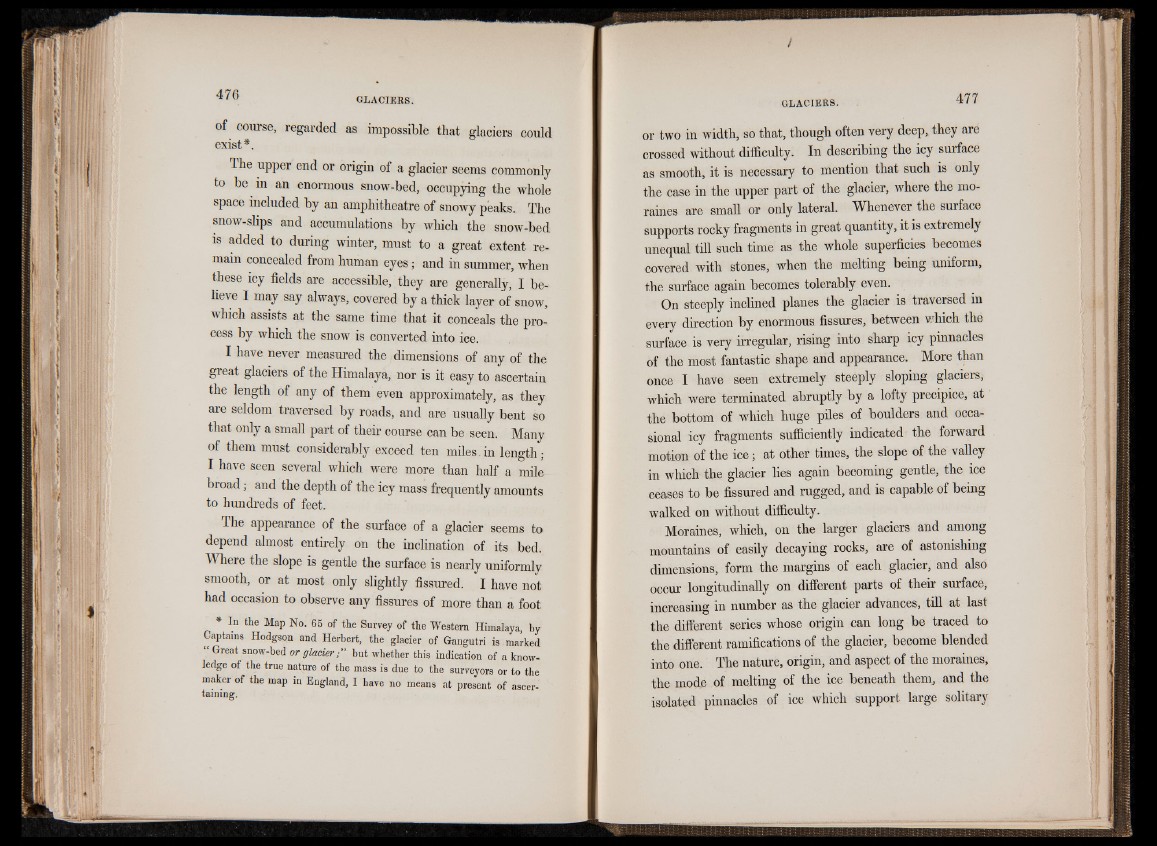
of course, regarded as impossible that glaciers could
exist*.
The upper end or origin of a glacier seems commonly
to be in an enormous snow-bed, occupying the whole
space included by an amphitheatre of snowy peaks. The
snow-slips and accumulations by which the snow-bed
is added to during winter, must to a great extent remain
concealed from human eyes; and in summer, when
these icy fields are accessible, they are generally, I believe
I may say always, covered by a thick layer of snow,
which assists at the same time that it conceals the process
by which the snow is converted into ice.
I have never measured the dimensions of any of the
great glaciers of the Himalaya, nor is it easy to ascertain
the length of any of them even approximately, as they
are seldom traversed by roads, and are usually bent so
that only a small part of their course can be seen. Many
of them must considerably exceed ten miles in length;
I have seen several which were more than half a mile
broad; and the depth of the icy mass frequently amounts
to hundreds of feet.
The appearance of the surface of a glacier seems to
depend almost entirely on the inclination of its bed.
Where the slope is gentle the surface is nearly uniformly
smooth, or at most only slightly fissured. I have not
had occasion to observe any fissures of more than a foot
* In the Map No. 65 of the Survey of the Western Himalaya, by
Captains Hodgson and Herbert, the glacier of Gangutri is marked
1 Great snow'bed or glacier ” but whether this indication of a knowledge
of the true nature of the mass is due to the surveyors or to the
maker of the map in England, I have no means at present of ascertaining.
/
or two in width, so that, though often very deep, they are
crossed without difficulty. In describing the icy surface
as smooth, it is necessary to mention that such is only
the case in the upper part of the glacier, where the moraines
are small or only lateral. Whenever the surface
supports rocky fragments in great quantity, it is extremely
unequal till such time as the whole superficies becomes
covered with stones, when the melting being uniform,
the surface again becomes tolerably even.
On steeply inclined planes the glacier is traversed in
every direction by enormous fissures, between which the
surface is very irregular, rising into sharp icy pinnacles
of the most fantastic shape and appearance. More than
once I have seen extremely steeply sloping glaciers,
which were terminated abruptly by a lofty precipice, at
the bottom of which huge piles of boulders and occasional
icy fragments sufficiently indicated the forward
motion of the ice; at other times, the slope of the valley
in which the glacier lies again becoming gentle, the ice
ceases to be fissured and rugged, and is capable of being
walked on without difficulty.
Moraines, which, on the larger glaciers and among
mountains of easily decaying rocks, are of astonishing
dimensions, form the margins of each glacier, and also
occur longitudinally on different parts of their surface,
increasing in number as the glacier advances, till at last
the different series whose origin can long be traced to
the different ramifications of the glacier, become blended
into one. The nature, origin, and aspect of the moraines,
the mode of melting of the ice beneath them, and the
isolated pinnacles of ice which support large solitary